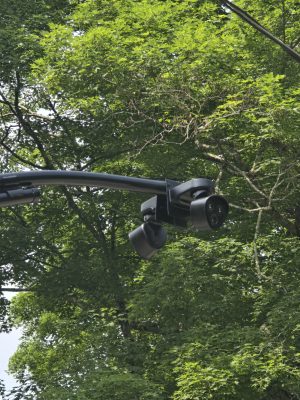Unexplained Surveillance Camera Sparks Debate in Pleasantville
News Based on facts, either observed and verified directly by the reporter, or reported and verified from knowledgeable sources.

By Toby Rosewater
Last month, residents at the junction of Bedford and Maple Hill Road in Pleasantville noticed a new camera hanging over the intersection.
The matte black device, mounted 15 feet high on a metal arm attached to a telephone pole, commands an unobstructed view of the crossing below.
For local residents, its sudden appearance has prompted questions about surveillance and safety, spurring mixed emotions.
“I wasn’t aware we needed more surveillance,” Bill Stoller, a Maple Hill Resident, told The Examiner. “I mean, why do we need more security in a relatively quiet suburban area?”
Peter Poller, also of Maple Hill, was more accepting of the development.
“If it’s all legal — I have no problem with it,” he shrugged.
Though opinions varied, many residents, including Lipton Tom, took serious issue with the lack of communication from local officials.
“We weren’t given any notice or explanation,” he said. “It feels like a decision made without resident input. People should have a say before something like this goes up in their neighborhood.”

An Expanding Network
According to Pleasantville Police Chief Erik Grutzner, the camera is an Automatic License Plate Reader (an ALPR), installed as part of a larger initiative to expand the community’s surveillance capabilities.
“It simply captures the license plate information of the cars that drive past it,” Grutzner noted.
The data, he emphasized, is not sold to third parties and is only accessed by other law enforcement agencies when necessary.
“We are trying to expand our network of cameras,” Grutzner said. “They have become an essential part of our public safety initiatives.”
The Cost
Notably, Pleasantville does not have an exclusive deal with a third-party vendor for these cameras, unlike the village of Scarsdale, which recently struck a $1.5 million deal with Flock Security Systems.
Instead, Pleasantville covers the cost of its diverse network using a mix of tax dollars, county funds, and federal or state grants.
An ALPR like the one at the junction of Maple Hill and Bedford Road, Grutzner said, costs around $10,000 to purchase and install.
“The money for the camera came from a New York State Grant, more specifically the LETECH grant,” Grutzner told The Examiner.
According to the LETECH grant application guidelines shared by the New York State Division of Criminal Justice Services, municipalities like Pleasantville are eligible to receive funding specifically for law enforcement technologies such as ALPRs, surveillance cameras, and other public safety equipment.
“For the first time, New York state asked us what technology we needed,” Grutzner said. “We asked for $75,000, and they wrote us a check.”
Concerns Remain
Despite the police department’s reassurances, local skepticism has persisted.
Among the initiative’s harshest critics is Jurij Paraszczak, a Pleasantville resident and former IBM researcher.
In a letter to local officials, Paraszczak outlined his concerns regarding privacy, data security, transparency, and the broader societal implications of expanding surveillance in Pleasantville.
“The problem, as I see it, is that this system breaches many layers of privacy,” Paraszczak wrote. “The majority of [this] data…has nothing, absolutely nothing to do with crime… [instead] it is valuable behavioral data.”
His call for greater disclosure and oversight reflects growing concerns not just in Pleasantville, but across Westchester County.

New York State Assembly member Amy Paulin — who declined to comment for this article — has repeatedly sponsored a bill calling for increased transparency around surveillance technology.
Among other things, her proposed legislation would require law enforcement agencies to publicly disclose the “minimum standards policy” governing ALPRs — a move aimed at ensuring residents have a clear understanding of how these systems are used and regulated.
A New Normal
Counting the new camera at the junction of Bedford and Maple Hill Road, Pleasantville now has a total of three license plate readers.
Such local expansion is part of a broader trend. In fact, open-source information indicates there are now at least 84 license plate readers currently operating across Westchester County.
“We are very committed to protecting people’s data,” Grutzner told The Examiner. “Our cameras are purely for law enforcement purposes and, above all else, they help keep the community safe.”
As Pleasantville and municipalities like it weigh the tradeoffs between public safety and civil liberties, it’s clear that this conversation will only continue to grow.
“I don’t want to upset people,” Paraszczak’s letter concludes, “but…Pleasantville is acquiring technology [that] is not yet regulated in New York, and as such, [they are] going ahead with its deployment without consulting or even informing village residents.”
On July 23, we corrected the name Lipton Tom, which was previously shown as Tom Lipton, and fixed the spelling of Peter Poller’s last name. The next day, July 24, we also included the number of license plate readers in Pleasantville.

Examiner Media – Keeping you informed with professionally-reported local news, features, and sports coverage.
